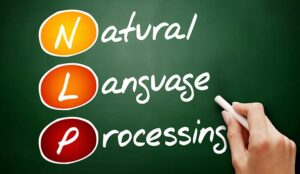Natural Language Processing is the set of techniques and approaches that enable machines to understand, interpret and generate language like that of human beings.
At the convergence of computer science, linguistics and artificial intelligence, NLP is a constantly evolving field of research and development.
Let’s dive into the world of NLP, where the convergence of AI technology and linguistics is redefining customer service standards.
Let’s discover how NLP is propelling the customer experience to new horizons, offering unprecedented opportunities for smarter, more human communication.
- How does AI understand natural language?
- What technologies are used in NLP?
- Understanding natural language: NLP as a concrete application
- Why is natural language processing (NLP) important for the customer service profession?
- What are the different applications of Natural Language Processing (NLP)?
How Does AI Understand Natural Language?
Artificial intelligence (AI) uses several approaches, including unsupervised, supervised, and reinforcement learning to understand natural language in sophisticated and contextual ways.
Unsupervised Learning:
This approach enables AI to discover intrinsic structures, patterns and relationships within natural language without the explicit guidance of annotated data.
This is particularly crucial in the context of Natural Language Processing (NLP), where the complexity of linguistic nuances, contexts and variations in human language requires deep understanding.
Unsupervised learning is therefore a powerful method for extracting relevant information, intelligently structuring data and paving the way for advanced applications such as automatic text generation and semantic analysis.
Supervised Learning:
In this process, the AI model is trained on annotated examples, enabling targeted language prediction and understanding.
This approach enables the development of specific systems, such as text classification, question answering and machine translation.
By taking advantage of annotations, supervised learning gives AI the ability to apprehend the nuances of human language and adapt to the diverse demands of users.
Reinforcement Learning:
In the context of Natural Language Processing, this branch of Artificial Intelligence enables a machine to interact with its context, making decisions and receiving rewards or penalties depending on the quality of its actions.
Thanks to this automatic learning mechanism, AI evolves iteratively, continually adjusting its performance to offer more precise and appropriate responses.
Reinforcement by learning thus broadens the horizons of AI in Natural Language Processing, contributing to smarter, more responsive applications, whether in conversational chatbots, virtual assistants, or advanced NLP systems.
What Technologies Are Used in NLP?
Natural Language Processing relies on a range of technologies. It is crucial to understand how concepts such as Machine Learning (ML) and Deep Learning (DL) intertwine to propel practical applications such as Natural Language Processing (NLP).
Throughout the history of AI, there has been a major shift from the initial combinatorial logic with simple conditional algorithms to more flexible and advanced approaches.
This evolution laid the crucial foundations for Machine Learning (ML), Deep Learning and Natural Language Processing (NLP).
Machine Learning: a First Step Towards Generative AI
What if computers could learn and solve problems without being explicitly programmed for each task?
That’s exactly what Machine Learning makes possible. Machine Learning (ML) models and algorithms enable computers to learn and act without being explicitly programmed for each task.
The emergence of Machine Learning has been an essential catalyst for change. By abandoning the static approaches of combinatorial logic, Machine Learning has introduced models capable of learning from experience, ushering in an era where machines can evolve and adapt dynamically to their environment.
The application of Machine Learning to tasks such as spam classification and detection has demonstrated a previously impossible agility and adaptability.
Deep Learning: Machines That Learn Like Humans
Deep Learning (DL) is a branch of Artificial Intelligence that focuses on creating models capable of learning complex representations of data in a similar way to how we humans learn to recognize and understand the world around us. Its emergence has been revolutionary.
By incorporating neural networks, Deep Learning has exponentially increased the ability of machines to analyze complex data.
Artificial neural networks play an essential role in enabling machines to mimic the way the human brain processes information.
This breakthrough has opened up exciting new perspectives, particularly in the field of NLP, where understanding natural language requires deeper, contextual analysis.
Today’s customer relationship chatbots rely on Deep Learning to understand human language naturally and detect nuances in customer queries.
Understanding Natural Language: NLP as a Concrete Application
Natural Language Processing (NLP) represents the harmonious marriage of Machine Learning and Deep Learning in the specific domain of human language.
To clarify, Machine Learning provided the general foundations for developing models, Deep Learning stepped in to deal with the complexity of language, and NLP is the application of these technologies to solve problems related to human language.
The Intimate Link Between Deep Learning and NLP
Machine Learning, Deep Learning, and Natural Language Processing (NLP) are closely linked and represent overlapping fields of Artificial Intelligence (AI).
To understand how Machine Learning, Deep Learning, and NLP interact, we need to see them as complementary elements:
Machine Learning as a Foundation
Machine Learning provides the foundations and general techniques used to develop learning models for all kinds of data, including text.
Deep Learning for Complexity
Deep Learning, thanks to its ability to work with deep neural networks, is particularly useful for dealing with the complexity and nuances of natural language in NLP.
NLP as a Specific Application
NLP is a field of application where Machine Learning and Deep Learning are applied to solve specific problems related to human language.
This synergy between Machine Learning, Deep Learning, and NLP is particularly crucial in the field of customer support.
In short, Machine Learning provides the basics, Deep Learning handles the complexity, and NLP applies these concepts to solve human language problems.
Why is Natural Language Processing (NLP) Important for the Customer Service Profession?
Firstly, NLP makes it possible to develop Artificial Intelligence capable of understanding human language, whether in text or voice form and in several languages.
This capability opens the door to the creation of chatbots, voicebots, and AIs capable of transcribing voice into text, as well as translating human language into different languages.
In this way, natural language processing (NLP) is positioning itself at the heart of the customer service business, bringing considerable benefits for both companies and consumers by offering smoother, more personalized experiences and improved service quality.
Contextual Personalization: Enhanced Engagement
NLP enables understanding of the complexity of human language for contextual personalization, a key feature for customer service.
By understanding the context of conversations, chatbots, and automated systems can provide specific responses, reinforcing customer engagement and creating a personalized experience.
Flexibility and Adaptation to Unique Customer Needs
NLP’s flexibility stands out when it comes to managing customer queries. This technology dynamically adapts to variations in requests and issues, ensuring an expert, individualized response.
This adaptability enhances operational efficiency and contributes to optimal customer satisfaction.
Immediate Responsiveness Thanks to Automated Language Processing
NLP’s automatic language processing ensures immediate responsiveness to customer queries.
This automation enables instant responses, improving customer service efficiency. Speed of response becomes a key factor in a positive customer experience…
In-depth Analysis of Customer Feedback for Continuous Improvement
NLP analysis of customer feedback provides an in-depth perspective on emerging concerns and trends.
This in-depth understanding enables continuous service improvement, ensuring a proactive response to changing customer expectations.
What Are the Different Applications of Natural Language Processing (NLP)?
An NLP-based AI solution automates various redundant tasks to simplify call centre work. This approach improves overall performance by making operations more efficient, providing seamless management of customer interactions, and optimizing overall contact centre Performance.
Transcription: Making Your Agent’s job Easier
By transcribing voice messages and conversations, agents can quickly resolve customer queries. Transcription becomes an effective way of saving time during the call. Transcription can:
- Reduce customer context time by 51%
- 97% reduction in post-call processing costs
- Reduce advisor evaluation time by 78%
Sentiment Analysis: Deciphering Customer Emotions
NLP algorithms can recognize the emotions expressed in customer messages, enabling companies to adjust their responses accordingly.
This fine-tuned understanding of feelings contributes to personalization and more empathetic interactions and greatly facilitates the agent’s work. As a result, our AI’s sentiment analysis has helped to reduce churn by an average of 12%.
Automatic Generation of Call Summaries: Speeding up Problem Resolution
Natural language processing enables the automatic generation of structured, customizable call summaries in a variety of formats: paragraphs, bulleted lists, and so on.
Integrating these summaries into CRM systems makes it easier for advisors to take context from future customer interactions, and reduces the amount of post-call work required.
Quality Monitoring: a Better Way to Analyze Agent Performance
Quality Monitoring is a process for evaluating interactions between agents and customers. It involves analyzing calls and other forms of interaction to ensure compliance with service standards and policies, and to identify opportunities for improvement.
Thanks to quality monitoring, advisors will not only be able to effectively target areas for improvement but also benefit from the intelligent analysis of AI to directly enhance their skills.
In this way, AI and NLP amplify companies’ operational performance, shape memorable customer experiences, and pave the way for a future where customer support is autonomous, efficient, and personalized. Ultimately, this facilitates the work of customer support agents, thereby reducing turnover.
NLP offers exceptional opportunities for companies wishing to modernize their contact centres. That’s why leading brands such as Carrefour Banque, ManoMano, Hager and many others choose Diabolocom, the expert in AI applied to customer relations.
Author: Guest Author
Published On: 11th Jan 2024 - Last modified: 9th Dec 2024
Read more about - Guest Blogs, Diabolocom





































